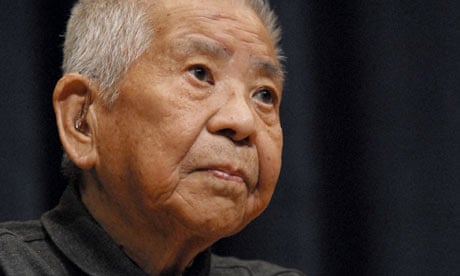It seems almost improper to suggest that fortune was smiling on Tsutomu Yamaguchi in the dying days of the second world war.
On 6 August 1945, he was in Hiroshima, preparing to return home from a business trip when the American B-29 bomber, the Enola Gay, dropped an atomic bomb on the city. Yamaguchi lived, while 140,000 other people who were in the city that morning died, some in an agonising instant, others many months later.
Burned and barely able to comprehend what had happened - only that he had witnessed a bomb unlike any used before - Yamaguchi spent a fitful night in an air raid shelter before returning home the following day.
That home, 180 miles to the west, was Nagasaki. His arrival came the day before it was devastated by a second US atomic bomb on 9 August.
In a barely conceivable course of events, he had twice been perilously close to nuclear ground zero; and both times he had lived. More than 70,000 other residents of Nagasaki were not so lucky.
More than 60 years later, the 93-year-old became the first and only known survivor of both attacks yesterday to win official recognition from Japanese authorities.
While other survivors died prematurely from cancer and liver disease caused by their exposure to radiation, Yamaguchi remains in relatively good health apart from near-deafness in one ear and complaints that his legs are "growing weak".
Japanese records show dozens of people experienced the blast in Hiroshima only to be exposed to "residual radiation" in Nagasaki three days later. But Yamaguchi is the first to have been at ground zero when both explosions occurred.
According to a newspaper interview Yamaguchi gave on the 60th anniversary of the end of the Pacific war, he had spent the conflict designing oil tankers for Mitsubishi Heavy Industries, a wartime zaibatsu, or conglomerate, whose shipyards dominated the Nagasaki skyline.
After a three-month stint at the firm's yards in Hiroshima, Yamaguchi and two colleagues, Akira Iwanaga and Kuniyoshi Sato, prepared to return to Nagasaki on 7 August, 1945. The day before, they woke early, collected their belongings and prepared for the train journey west.
On the way to the station they became separated after Yamaguchi realised he had left his personal seal in the office.
He remembers hearing the Enola Gay circling above, but thought nothing of it: Hiroshima was an important wartime industrial base, and the sound of circling planes had become a fact of life.
Within seconds he had been knocked off his feet by the force of the blast as "Little Boy" detonated 580 metres above central Hiroshima just after 8.15 am, announcing its arrival with a blinding flash followed by a deafening boom. As he stumbled to the train station the next day, Yamaguchi witnessed the destruction and carnage left by the bomber's 13-kiloton payload.
The following day, his burns swathed in bandages, Yamaguchi reported for work in Nagasaki, like Hiroshima an important industrial and military base.
At 11.02 on 9 August, as his boss reportedly questioned his sanity for believing that a single bomb could destroy a city the size of Hiroshima, a 25-kiloton plutonium bomb exploded above Nagasaki, throwing Yamaguchi to the ground.
He, his wife and baby son survived and spent the following week in a shelter near what was left of their home. His son has since died of cancer aged 59.
After the war Yamaguchi worked for the US occupation authorities, became a teacher and eventually returned to Mitsubishi Heavy Industries.
Yamaguchi was quoted yesterday by the Mainichi newspaper. "My double radiation exposure is now an official government record. It can tell the younger generation the horrifying history of the atomic bombings even after I die," he said.
As a registered survivor of the Nagasaki bombing, Yamaguchi has owned a pale violet copy of the Atomic Bomb Victim Health Handbook since 1957, entitling him to monthly allowances, free medical checkups and funeral costs. More than 260,000 others are similarly covered.
Yamaguchi's handbook confirmed he was within a three-kilometre radius of ground zero in both cities, but the reference to Hiroshima was deleted when he renewed it at Nagasaki city hall in 1960.
Officials refused to recognise Yamaguchi's special status because, they said, it would not affect his medical and welfare entitlements, but relented after he filed another request earlier this year.
"As far as we know, he is the first one to be officially recognised as a survivor of atomic bombings," Toshiro Miyamoto, a Nagasaki city official, told the Associated Press. "It's such an unfortunate case, but it is possible there are more like him."
Survivors' stories
Violet Jessop survived the sinking of the Titanic, on which she was working as a stewardess. Four years later she escaped with her life when the hospital ship Britannic, on which she was serving as a nurse, struck a mine.
Rodney Cocks was metres away from Paddy's Irish Bar in Bali when the first bomb went off in 2002. Less than 10 months later he left his desk just in time to avoid the full impact of a suicide bomb at the UN office in Baghdad.
Bill Stone was the last known veteran living in the UK to have served in the first and second world wars. He died this year at the age of 108.
Roger Villar survived being sunk twice during the second world war. He was on the destroyer Mohawk when it was hit by the Italian flagship Luca Tarigo, but he was rescued by a destroyer. During Operation Torch his vessel was sunk by a German bomber but he escaped unscathed.
Holly Bentley
